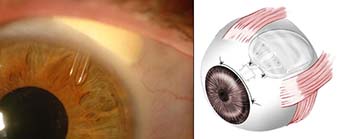Glaucoma

Minimally invasive glaucoma surgery
Minimally invasive glaucoma surgery has emerged as a new and effective treatment for patients with glaucoma. It is a microinvasive surgery with a very high safety profile and rapid post-operative recovery. It has greatly improved the quality of life for many glaucoma patients by reducing the number of glaucoma drops required by a patient after the procedure.
Istent inject allows increased drainage of fluid and lowers the intraocular pressure.


Hydrus microstent decreases outflow by 3 ways: enhancing outflow, expand the eye’s natural fluid pathway and reduing pressure reliably.


Glaucoma is the disease of the optic nerve, which results is visual field loss. The optic nerve which contains nerve fibres carries electric signals to the eye. Severe damage to the nerve could result in blindness.
- Increasing age > 50 years old
- Positive family history of glaucoma
- High eye pressure
- Asian and African descent
- Females
- Systemic Diseases (Diabetes, Obstructive sleep apnoea, Cardiovascular diseases)
- Myopia or Hyperopia
- Trauma to the eye
- Previous eye surgery
- Use of steroids (cortisone medications)
- Females

Open- angle glaucoma
- Primary Open Angle Glaucoma
- Ocular hypertension (Glaucoma suspects) is classified as increased intraocular pressure without optic disc damage or visual field changes. Ocular hypertensives are glaucoma suspects and should be screened every year.
- Normal-Tension Glaucoma
Close-Angle Glaucoma
- It occurs when there is obstruction of the flow of fluid through the drainage angle, this result in the increase in intraocular pressure, optic nerve damage and visual field loss. Blindness can result very quickly if untreated.
- Acute primary angle closure glaucoma is an ocular emergency. It commonly occurs in Asians. Symptoms include sudden eye pain and redness, blurred vision, haloes, nausea, vomiting and headaches. Blindness can result very quickly if untreated.
Secondary glaucoma can be caused by trauma, inflammation and intraocular tumours.
Congenital glaucoma occurs due to the underdevelopment of the drainage structures.
The damaged caused by glaucoma cannot be reversed. But treatment and regular eye drops can slow the progression and prevent vision loss.
Glaucoma is treated by lowering your eye pressure. Depending on the patient, your options may include prescription eye drops, oral medications, laser or surgery depending on the type and severity of glaucoma.
The initial treatment of glaucoma often starts with prescription drops. The eyedrops help decrease the eye pressure by increasing drainage or decreasing the amount of fluid your eye makes.

Laser is an outpatient procedure done in the clinic. Laser treatment can be used to treat some types of glaucoma.
Laser iridotomy/ iridoplasty can be performed for angle closure glaucoma to relieve pupil block and helps widen the outflow drainage angle. It can prevent acute angle closure glaucoma.

Selective laser trabeculopasty is usually recommended for open angle glaucoma to increase outflow of the angle to decrease eye pressure. It is a safe procedure and can be repeated.
Trabeculectomy is a filtering surgery can be performed by creating an opening on the eye for fluid inside the eye to be drained.

Tube- shunt surgery is a flexible glaucoma drainage device placed into the eye to drain excess fluid out of the eye.





 BACK
BACK